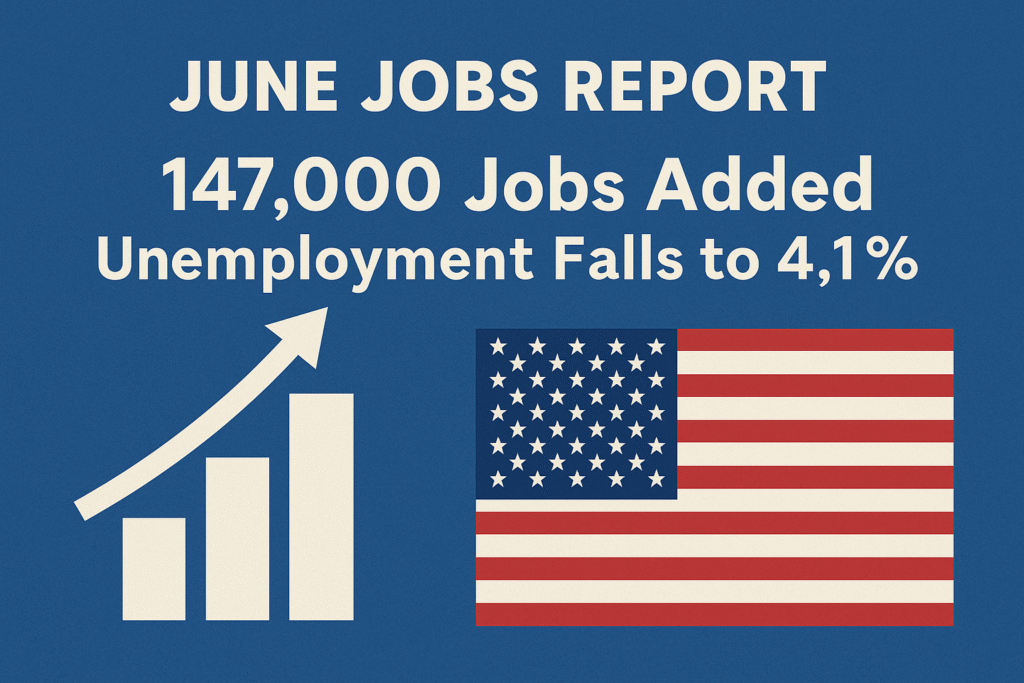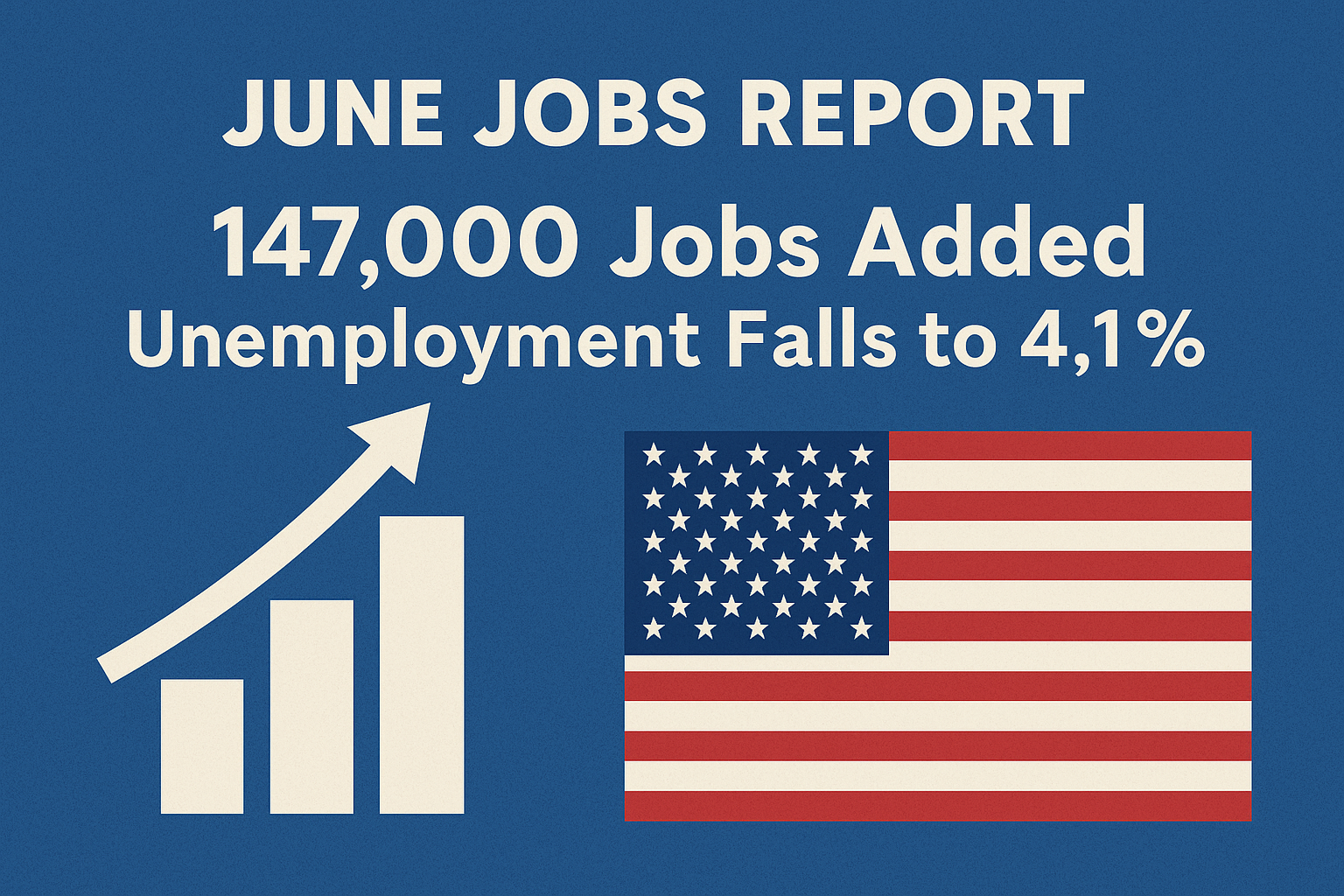The June Jobs Report has painted a surprisingly resilient picture of the U.S. labor market, defying expectations of a sharper slowdown. According to the data released by the Bureau of Labor Statistics (BLS), the U.S. economy added 147,000 nonfarm payrolls in June, outperforming economists’ expectations of just 106,000 job gains. Even more surprising was the drop in the unemployment rate, which fell to 4.1%, contrary to forecasts predicting a rise to 4.3%.
This June Jobs Report underscores the economy’s strength despite ongoing global headwinds, monetary tightening, and uncertainty around trade and tariffs. It confirms that while job growth has slowed compared to the highs of the post-pandemic recovery, it remains solid enough to maintain economic momentum through the second half of the year.
June Jobs Report: A Sign of Economic Resilience
One of the most notable aspects of the June Jobs Report is its reflection of a labor market that is slowing — but in a stable and measured way. Joe Brusuelas, Chief Economist at RSM, told Yahoo Finance that “You’re just not seeing any feed-through from tariff or trade-related stress.” According to him, the report is “absolutely solid” and supports the outlook of a “slowing but solid economy.”
This assessment aligns with broader economic indicators. While job creation has cooled from its rapid pace in 2021 and 2022, the gains in the June Jobs Report show the labor market is far from stalling.
Unemployment Falls Despite Expectations of a Rise
The June Jobs Report surprised analysts with a decline in the unemployment rate to 4.1%. Most economists had anticipated a slight uptick due to slowing hiring and growing labor force participation. Instead, the rate dropped from 4.2% in May.
Interestingly, the labor force participation rate also declined slightly to 62.3% from 62.4%, which may partly explain the drop in unemployment. Still, the fall contradicts expectations of a cooling labor market and suggests employers are still hiring, albeit cautiously.
Revisions and Context: Comparing to May’s Figures
Adding to the strength of the June Jobs Report is a positive revision to May’s job numbers. Previously reported at 139,000, May’s job gains were revised upward to 144,000. These back-to-back gains reinforce that the labor market has not significantly deteriorated, despite early signals to the contrary from other employment data.
Private sector job creation, measured by ADP, showed a decline of 33,000 jobs in June — the first since March 2023. But the June Jobs Report counters that with broader-based strength, particularly in public sector employment.
Government Hiring Drives Job Gains
A standout feature of the June Jobs Report is the surge in government hiring. The public sector added 73,000 new jobs in June, accounting for roughly half of the month’s employment growth. This increase may reflect seasonal trends, local government hiring, or expanded federal programs.
While heavy reliance on government hiring can signal slowing private sector activity, in this case, it appears to provide a cushion during a transitional period in the labor market.
Wage Growth and Earnings: A Mixed Bag
Another key detail in the June Jobs Report is wage growth. Average hourly earnings rose 0.2% in June, below expectations of a 0.3% rise. On a year-over-year basis, wages increased by 3.7%, also slightly below the 3.8% economists had predicted.
While slower wage growth may seem negative at first glance, it’s actually welcome news for the Federal Reserve. Slowing earnings can help ease inflationary pressure without leading to job losses — an ideal scenario for policymakers aiming for a “soft landing.”
Federal Reserve Outlook: Market Bets Cool on Rate Cuts
Prior to the release of the June Jobs Report, markets were pricing in a strong chance of a July rate cut from the Federal Reserve. However, the better-than-expected numbers have tempered those expectations. According to the CME FedWatch Tool, the probability of a July rate cut has dropped to just 5%, down from 24% the day before.
Even expectations for a September cut have softened, with market bets declining from 94% to 78% following the release of the June Jobs Report. The Fed will likely interpret this data as a reason to delay any hasty moves on interest rates.
Broader Labor Market Trends: Quits, Hiring, and Openings
The June Jobs Report comes amid conflicting signals in broader labor market data. The latest Job Openings and Labor Turnover Survey (JOLTS) showed job openings at their highest level since November 2024. However, both the quits rate and hiring rate remain at decade lows, indicating that workers may feel less confident about switching jobs or negotiating higher pay.
This contradiction — between job availability and worker caution — may indicate an evolving labor market that’s still stable but less dynamic than in past years.
Slower Labor Force Growth May Skew Unemployment Numbers
Oxford Economics lead U.S. economist Nancy Vanden Houten noted that slower labor force growth could keep the unemployment rate low even if the number of unemployed individuals rises. This nuance in the June Jobs Report should not be overlooked. It suggests that while headline figures look strong, underlying trends could create challenges if workforce participation does not rebound.
Hiring Momentum Slows, But No Job Collapse Expected
ADP Chief Economist Nela Richardson commented on the June Jobs Report in light of recent ADP data, stating that while hiring momentum has clearly slowed, the outlook does not suggest consistent job losses. “That doesn’t mean the second half of the year will bring consistent job declines,” she said.
Instead, the economy appears to be entering a new phase of normalization. The June Jobs Report confirms that although job creation is moderating, it’s still strong enough to avoid recession fears.
What the June Jobs Report Means for Americans
For job seekers, the June Jobs Report brings both reassurance and caution. Job growth remains positive, particularly in government and certain service sectors. However, the decline in wage growth and slight drop in participation rates may mean fewer opportunities in some areas.
Employers, meanwhile, are likely to continue hiring conservatively while watching inflation, consumer spending, and monetary policy decisions. For policymakers, the June Jobs Report presents a challenge: how to support growth without fueling inflation or undermining market confidence.
Final Thoughts: June Jobs Report Confirms Solid but Slowing Market
The June Jobs Report offers a clear message: the U.S. labor market remains resilient, even as headwinds intensify. Job gains beat expectations, the unemployment rate fell, and wage pressures eased — a combination that gives the Federal Reserve breathing room and boosts public confidence in the economy.
While risks remain — including slower private hiring and declining participation — the overall labor market picture is one of stability. The June Jobs Report doesn’t just reflect past performance; it sets the tone for what could be a steady but cautious second half of 2025.


One thought on “June Jobs Report: 147,000 New Jobs Added, U.S. Unemployment Falls to 4.1%”
Comments are closed.